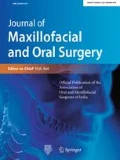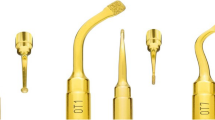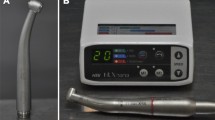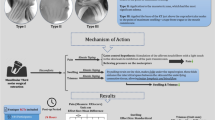Abstract
Aim
The aim of this systematic review and meta-analysis was to compare, in the lower third molar surgery, the osteotomy techniques with rotary instruments and piezoelectric motors.
Methods
An electronic search was conducted using the following databases: Pubmed, Web of Science, and the Cochrane Oral Health Group Trials Register. Inclusion criteria were: studies in humans, randomized or nonrandomized, comparing the extraction of third molars that required osteotomy and/or odontosection with rotary instrument and osteotomy and/or odontosection with piezoelectric motor assistance. The analysis and inclusion of articles was performed by two reviewers independently. An evaluation of the quality of articles and data extraction was carried out.
Results
From a total of nine hundred seventy four (974) trials, eleven articles were included in the qualitative analysis, and seven were included in the quantitative analysis. Rotary instruments were faster than the piezoelectric surgery (95 % CI 0.34 to 1.16). The piezoelectric surgery showed better results when compared with roatry instruments when trismus was assessed in 2 (95 % CI 0.65 to 1.69), 3 (95 % CI 0.63 to 1.67) and 5 (95 % CI 0.03 to 2.26) days after surgery. Seven days after surgery, there were no differences between the techniques (95 % CI (−0.022) to (−1.49)).
Conclusion
The piezoelectric surgery was effective in reducing pain, swelling and trismus in third molar surgery, but the same requires greater surgical time than the rotary instruments.



Similar content being viewed by others
References
Falci SG, de Castro CR, Santos RC, de Souza Lima LD, Ramos-Jorge ML, Botelho AM, dos Santos CR (2012) Association between the presence of partially erupted mandibular third molar and the existence of caries in the distal of the second molars. Int J Oral Maxillofac Surg 41:1270–1274
Nunn ME, Fish MD, Garcia RI, Kaye EK, Figueroa R, Gohel A, Ito M, Lee HJ, Williams DE, Miyamoto T (2013) Retained asymptomatic third molars and risk for second molar pathology. J Dent Res 92:1095–1099
Renton T, Smeeton N, McGurk M (2001) Factors predictive of difficulty of mandibular third molar surgery. Br Dent J 190:607–610
Alcântara CE, Falci SG, Oliveira-Ferreira F, Santos CR, Pinheiro ML (2014) Pre-emptive effect of dexamethasone and methylprednisolone on pain, swelling, and trismus after third molar surgery: a split-mouth randomized triple-blind clinical trial. Int J Oral Maxillofac Surg 43:93–98
Slade GD, Foy SP, Shugars DA, Phillips C, White RP Jr (2004) The impact of third molar symptoms, pain, and swelling on oral health-related quality of life. J Oral Maxillofac Surg 62:1118–1124
Royer RQ (1969) Use of the chisel in the removal of impacted mandibular third molars. J Oral Surg 27:26–31
Absi EG, Shepherd JP (1993) A comparison of morbidity following the removal of lower third molars by the lingual split and surgical bur methods. Int J Oral Maxillofac Surg 22:149–153
Campbell JH, Murray RA (2004) Handpiece speed and postoperative outcomes in third molar surgery. J Indiana Dent Assoc 83:4–6
Monnazzi MS, Real Gabrielli MF, Passeri LA, Cabrini Gabrielli MA, Spin-Neto R, Pereira-Filho VA (2014) Inferior alveolar nerve function after sagittal split osteotomy by reciprocating saw or piezosurgery instrument: prospective double-blinded study. J Oral Maxillofac Surg 72:1168–1172
Bassetti R, Bassetti M, Mericske-Stern R, Enkling N (2013) Piezoelectric alveolar ridge-splitting technique with simultaneous implant placement: a cohort study with 2-year radiographic results. Int J Oral Maxillofac Implants 28:1570–1580
da Silva Neto UT, Joly JC, Gehrke AS (2014) Clinical analysis of the stability of dental implants after preparation of the site by conventional drilling or piezosurgery. Br J Oral Maxillofac Surg 52:149–153
Camargo Filho GP, Corrêa L, Costa C, Pannuti CM, Schmelzeisen R, Luz JG (2010) Comparative study of two autogenous graft techniques using piezosugery for sinus lifting. Acta Cir Bras 25:485–489
Mouraret S, Houschyar KS, Hunter DJ, Smith AA, Jew OS, Girod S, Helms JA (2014) Cell viability after osteotomy and bone harvesting: comparison of piezoelectric surgery and conventional bur. Int J Oral Maxillofac Surg 43:966–971
Mantovani E, Arduino PG, Schierano G, Ferrero L, Gallesio G, Mozzati M, Russo A, Scully C, Carossa S (2014) A split-mouth randomized clinical trial to evaluate the performance of piezosurgery compared with traditional technique in lower wisdom tooth removal. J Oral Maxillofac Surg 72:1890–1897
Barone A, Marconcini S, Giacomelli L, Rispoli L, Calvo JL, Covni U (2010) A randomized clinical evaluation of ultrasound bone surgery versus traditional rotary instruments in lower third molar extraction. J Oral Maxillofac Surg 68:330–336
Moher D, Liberati A, Tetzlaff J, Altman DG, PRISMA Group (2009) Reprint—preferred reporting items for systematic reviews and meta-analyses: the PRISMA statement. Phys Ther 89:873–880
Higgins JPT, Green S. Cochrane handbook for systematic reviews of interventions. Version 5.1.0 [updated March 2011]. The Cochrane Collaboration, 2011. http://www.cochrane-handbook.org
Borenstein M, Hedges LV, Higgins J, Rothsten H (2005) Comprehensive meta-analysis version 2. Biostat, Englewood
Higgins JP, Thompson SG (2002) Quantifying heterogeneity in meta-analysis. Stat Med 21:1539–1558
Borensterin M, Hedges LV, Higgins J, HR Rothstein (2009) Introduction to meta-analysis. Wiley, Chichester
Biljana M, Jelena M, Branislav J, Milorad R (1999) Bias in meta-analysis and funnel plot asymmetry. Stud Health Technol Inform 68:323–328
Egger M, Davey SG, Schneider M, Minder C (1997) Bias in meta-analysis detected by a simple, graphical test. BMJ 315:629–634
Goyal M, Mrya K, Jhamb A, Chawala S, Sonoo PR, Singh V, Aggarwal A (2012) Comparative evaluation of surgical outcome after removal of impacted mandibular third molars using a Piezotome or a conventional handpiece: a prospective study. Br J Oral Maxillofac Surg 50:556–561
Rullo R, Addaboo F, Papaccio G, D’Aquino R, Festa VW (2013) Piezoelectric device vs. Conventional rotative instruments in impacted third molar surgery: relationships between surgical difficulty and postoperative pain with histological evaluations. J Craniomaxillofac Surg 41:33–38
Sivolella S, Berengo M, Bressan E, Di Fiore A, Stellini E (2011) Osteotomy for lower third molar germectomy: randomized prospective crossover clinical study comparing piezosurgery and conventional rotator osteotomy. J Oral Maxillofac Surg 69:15–23
Bartuli FN, Luciani F, Caddeo F, De Chiara L, Di Dio M, Piva P, Ottria L, Arcuri C (2013) Piezosurgery vs High Speed Rotatory Handpiece: a comparison between the two techniques in the impacted third molar surgery. Oral Implantol (Rome) 6:5–10
Chang HH, Lee MS, Hsu YC, Tsai SJ, Lin CP (2015) Comparison of clinical parameters and environmental noise levels between regular surgery and piezosurgery for extraction of impacted third molars. J Formos Med Assoc 114:929–935
Piersanti L, Dilorenzo M, Monaco G, Marchetti C (2014) Piezosurgery of conventional rotator instruments for inferior third molar extractions? J Oral Maxillofac Surg 72:1647–1652
Sortino F, Pedullà E, Masoli V (2008) The piezoelectric and rotatory osteotomy technique in impacted third molar surgery: comparison of postoperative recovery. J Oral Maxillofac Surg 66:2444–2448
Itro A, Lupo G, Marra A, Carotenuto A, Cocozza E, Filipi M, D’Amato S (2012) The piezoeletric osteotomy technique compared to the one with rotatory instruments in the surgery of included third molars. A clinical study. Minerva Stomatol 61:247–253
Lopez-Lopez J, Jan-Pallí E, González-Navarro B, Jané-Salas E, Estrugo-Devesa A, Milani M (2015) Efficacy of chlorexidine, dexpanthenol, allantoin and chitosan gel in comparison with bicarbonate oral rinse in controlling post-interventional inflamation, pain and cicatrization in subjects undergoing dental surgery. Curr Med Res Opin 15:1–16
Beziat JL, Bera JC, Lavandier B, Gleizal A (2007) Ultrasonic osteotomy as a new technique in craniomaxillofacial surgery. Int J Oral Maxillofac Surg 36:493–500
Lago-Mendez L, Diniz-Freitas M, Senra-Rivera C, Gude-Sampedro F, Gándara Rey JM, García-García A (2007) Relationship between surgical difficulty and postoperative pain in lower third molar extractions. J Oral Maxillofac Surg 65:979–983
Grossi GB, Maiorana C, Garramone RA, Borgonovo A, Beretta M, Farronato D, Santoro F (2007) Effect of submucosal injection of dexamethasone on postoperative discomfort after third molar surgery: a prospective study. J Oral Maxillofac Surg 65:2218–2226
Jiang Q, Qiu Y, Yang J, Chen M, Zhang Z (2015) Piezoeletric versus conventional rotatory techniques for impacted third molar extraction: a meta-analysis of randomized controlled trials. Medicine (Baltimore) 94:1685. doi:10.1097/MD.0000000000001685
Author information
Authors and Affiliations
Corresponding author
Ethics declarations
Ethical standards
As this work is a systematic review and meta-analysis, the ethical approval in an ethics committee is not necessary.
Conflicts of interest
The authors state that there are no conflicts of interest in this paper.
Informed consent
As this research did not involve human beings, informed consent was not necessary.
Rights and permissions
About this article
Cite this article
Magesty, R.A., Galvão, E.L., de Castro Martins, C. et al. Rotary Instrument or Piezoelectric for the Removal of Third Molars: a Meta-Analysis. J. Maxillofac. Oral Surg. 16, 13–21 (2017). https://doi.org/10.1007/s12663-016-0938-y
Received:
Accepted:
Published:
Issue Date:
DOI: https://doi.org/10.1007/s12663-016-0938-y




